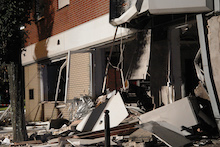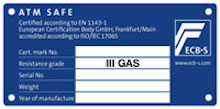
Caption:
Photo Nr. 168 Gas attacks on ATMs are no longer a rarity. Indeed, the damage to the credit institutions is not only limited to the stolen money. Photo: ECB
Photo:
ECB

Caption:
Photo Nr. 210 The optional test GAS according to EN 1143-1 protects efficiently against gas attacks and is also noted on the certification mark.
Photo:
ECB
ECB•S: Gas Attacks on ATMs – Credit Institutions should consider refitting
Frankfurt/M. – March 2017. The increasing number of gas attacks on ATMs does not seem to be an only German phenomenon. Our European neighbours are also affected by this negative trend. While 157 cases were reported in Germany in 2015, this number has already doubled for 2016 - the main regions being Berlin, Lower Saxony and North Rhine-Westphalia. At the European level, the figures rose as well, by about 80% in the first half of 2016 compared to the previous year.
In Germany, there are around 58,000 ATMs, whereas the total number of ATMs in the European Union amounts to 450,000. For the amateur, the above-mentioned incidents therefore seem manageable at first sight. Considering, however, that many ATMs are not freely exposed but located in inhabited or highly frequented buildings, one already suspects that a gas attack and the associated blasting can bring not only an enormous property damage but also considerable personal injury.
These developments force banks and savings banks to react - even if they are not allowed to provide precise information on their specific safety measures. There are several ways in which credit institutions can meet to protect themselves and their customers. One possibility of deterrence is the use of mechanisms that color the money with a special ink during severe shocks and thus make the money worthless. In the Netherlands, this technology has already been used comprehensively nationwide. However, blasting and the resulting damage are not prevented. Additionally, this will not be a deterrent for organized gangs, since there are already chemicals on the market which can remove the discoloration from the bank notes – at least in some cases.
In order to fully prevent blasting, the design of the ATM should be scrutinized more closely. Various methods can make it possible for gas to leak or to be neutralized directly after entry into the ATMs. There is also the possibility to prepare ATMs in such a way that generally less gas can be introduced. Blasting can thus be prevented or at least reduced in its extent.
The probably most efficient approach is to build a stronger vault for the ATM so that it can withstand the explosion from the inside as well as from the outside. As of 2012, vaults for ATMs which are tested according to the EN 1143-1 standard, can additionally be tested regarding gas attacks. During the test, a gas mixture is introduced into a vault. The gas mixture is then being ignited subsequently. After the "explosion", the vault is attacked for a short period of time using the standard burglar tools. If the vault remains closed, it passed the test. The addition of GAS will then be noted on the certification mark.
"In general it is possible to protect ATMs efficiently from gas attacks. The additional option of GAS in burglary testing according to the standard EN 1143-1 should not only be an option for banks and savings banks, but should be included as an integral part of the security concept of all credit institutions. In the year 2016, ECB already issued 14,900 certification marks with the additional option GAS ", says Dr. Markus Heering of the European Certification Body GmbH in Frankfurt am Main."Colour dyes for money cassettes are always recommendable as a back-up, but should never be the main protection measure against gas attacks. Making savings at the wrong end may well be a source of not only financial but also reputational damage."
These developments force banks and savings banks to react - even if they are not allowed to provide precise information on their specific safety measures. There are several ways in which credit institutions can meet to protect themselves and their customers. One possibility of deterrence is the use of mechanisms that color the money with a special ink during severe shocks and thus make the money worthless. In the Netherlands, this technology has already been used comprehensively nationwide. However, blasting and the resulting damage are not prevented. Additionally, this will not be a deterrent for organized gangs, since there are already chemicals on the market which can remove the discoloration from the bank notes – at least in some cases.
In order to fully prevent blasting, the design of the ATM should be scrutinized more closely. Various methods can make it possible for gas to leak or to be neutralized directly after entry into the ATMs. There is also the possibility to prepare ATMs in such a way that generally less gas can be introduced. Blasting can thus be prevented or at least reduced in its extent.
The probably most efficient approach is to build a stronger vault for the ATM so that it can withstand the explosion from the inside as well as from the outside. As of 2012, vaults for ATMs which are tested according to the EN 1143-1 standard, can additionally be tested regarding gas attacks. During the test, a gas mixture is introduced into a vault. The gas mixture is then being ignited subsequently. After the "explosion", the vault is attacked for a short period of time using the standard burglar tools. If the vault remains closed, it passed the test. The addition of GAS will then be noted on the certification mark.
"In general it is possible to protect ATMs efficiently from gas attacks. The additional option of GAS in burglary testing according to the standard EN 1143-1 should not only be an option for banks and savings banks, but should be included as an integral part of the security concept of all credit institutions. In the year 2016, ECB already issued 14,900 certification marks with the additional option GAS ", says Dr. Markus Heering of the European Certification Body GmbH in Frankfurt am Main."Colour dyes for money cassettes are always recommendable as a back-up, but should never be the main protection measure against gas attacks. Making savings at the wrong end may well be a source of not only financial but also reputational damage."
Text: 16th March 2017 characters incl. spaces
As of: 3.405

